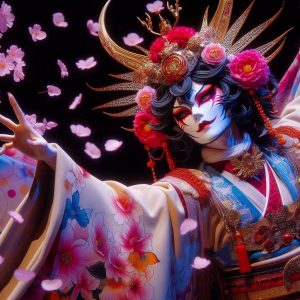Author: ShiroiYozora 10.09.2024
Forget Broadway, What is Kabuki and Why It's the Next Big Thing in Entertainment
Contents
- 1 Forget Broadway, What is Kabuki and Why It's the Next Big Thing in Entertainment
- 2 Other!
- 2.0.1 Other Interesting Things!
- 2.0.2 Blog Posts!
- 2.0.2.1 What is Japandi Style and Why is it Popular?
- 2.0.2.2 The Dark Side of Kawaii: Shocking Japan Statistics Nobody’s Talking About
- 2.0.2.3 From Bowing to Slurping: The Shocking Truth About Japanese Manners That Every Traveler Needs to Know
- 2.0.2.4 Forget Broadway, What is Kabuki and Why It’s the Next Big Thing in Entertainment
- 2.0.2.5 From Studio Ghibli to Sailor Moon: The Surprising Impact of Cats in Anime
- 2.0.2.6 From Samurai Snack to Global Phenomenon: The Surprising History of Ramen
- 2.0.2.7 The Legendary Katana: From Ancient Battlefields to Modern Screens
When you think of theater, you might immediately envision the dazzling lights and breathtaking performances of Broadway. But, what if I told you there's an enchanting world of theatrical art that may soon steal the spotlight? Enter Kabuki – a traditional Japanese performance art that's poised to become the next big sensation in the entertainment world. This article will introduce you to Kabuki, unravel its rich history, distinct elements, and explore why it's capturing global audiences' attention like never before.
This site contains affiliate links to products. We may receive a commission for purchases made through these links. Learn more.

What Is Kabuki?
A Brief History of Kabuki
Kabuki, originating in the early 17th century, is a classical Japanese dance-drama known for its highly stylized performances, elaborate costumes, and eye-catching make-up. The origins of Kabuki can be traced back to Izumo no Okuni, a shrine maiden who performed in Kyoto in 1603. Her innovative and bold dance-drama routines laid the groundwork for what would become a revered cultural treasure.
Kabuki flourished during the Edo period (1603-1868) and has since evolved, reflecting various social changes in Japan. Despite facing periods of suppression, Kabuki has remained resilient, preserving its cultural significance. Today, Kabuki is recognized by UNESCO as an intangible cultural heritage, symbolizing the enduring legacy of Japanese performing arts.
Key Elements of Kabuki
Costumes and Make-up
Costumes and make-up hold a pivotal role in Kabuki performances. The actors are adorned in elaborate outfits that signify their characters' social status, personality, and gender. For instance, heroes often wear bold colors and elaborate wigs, while villains are depicted in darker shades. The intricate make-up, known as "Kumadori," uses color to convey emotion and personality. Red hues typically represent passion and bravery, whereas blue signifies evil or sorrow.
Distinct Acting Styles
Kabuki actors, known as "Kabuki-ka," employ specific acting techniques like "Mie" – where the performer strikes a dramatic pose and holds it momentarily to emphasize a climactic point. This theatrical style ensures that the audience remains captivated, feeling the intensity and emotion of the scene.
Music and Instruments
Music is an integral component of Kabuki, punctuating scenes and accentuating emotions. Traditional Japanese instruments like the shamisen (a three-stringed instrument) and taiko drums provide the musical backdrop. The music, combined with the actors' vocal expressions, creates a rich aural experience that complements the visual spectacle of the performance.

Kabuki masks.
Why Kabuki Is Capturing Global Attention
Cultural Appeal
Kabuki's authenticity and rich cultural heritage offer a refreshing contrast to contemporary Western theater. For those seeking a deeper connection to traditional art forms, Kabuki provides an immersive window into Japanese history and culture.
Visual Extravaganza
In an age where visual content dominates, Kabuki's stunning visual elements – from vibrant costumes to electrifying stage effects – can mesmerize audiences. The vivid imagery and colorful spectacle appeal to modern viewers who crave thrilling and visually engaging entertainment.
Storytelling Excellence
Kabuki narratives often revolve around timeless themes of love, honor, and betrayal, resonating with audiences across cultures. The stories, though rooted in Japanese folklore and history, carry universal themes that many can relate to, thereby broadening its appeal.
Technological Integration
Interestingly, modern Kabuki has embraced technology to enhance its performances. Elements like digital projections and LED lighting are incorporated to create immersive, multidimensional experiences, merging traditional art with contemporary innovation.
How to Experience Kabuki
In Japan
The best way to experience authentic Kabuki is to visit renowned theaters in Japan such as the Kabukiza Theatre in Tokyo or the Minami-za Theatre in Kyoto. These venues offer a range of performances, including short acts suitable for beginners and full-day shows for enthusiasts.
International Stages
Kabuki's growing popularity has led to international tours and performances in cities like New York, London, and Paris. Keep an eye on local theater listings for opportunities to witness Kabuki closer to home.
Virtual Experiences
For those who cannot make it to a live show, various online platforms and streaming services offer recordings of Kabuki performances. This provides a convenient way to explore this art form from the comfort of your home.
Conclusion
Kabuki's unique blend of historical depth, visual splendor, and emotional storytelling sets it apart as an extraordinary form of entertainment. As more people worldwide discover the magic of Kabuki, it's poised to become a significant cultural phenomenon. Whether you're a theater aficionado or a curious newbie, Kabuki promises an unforgettable journey into the heart of Japanese performing arts.
"Kabuki opens a door to a world where tradition meets innovation – an experience not to be missed."
Explore Kabuki and let its mesmerizing charm transport you to a bygone era filled with drama, beauty, and timeless tales.

Other!
Other Interesting Things!
Blog Posts!
Shiroi Castle is a participant in the Amazon Services LLC Associates Program, an affiliate advertising program designed to provide a means for sites to earn advertising fees by advertising and linking to Amazon.com. Amazon, the Amazon logo, AmazonSupply, and the AmazonSupply logo are trademarks of Amazon.com, Inc., or its affiliates.
Some of the graphics used to design the website has been created by Freepik www.freepik.com, using Adobe Firefly AI or Microsoft Designer.

















